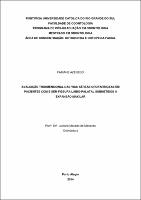| Share record |


|
Please use this identifier to cite or link to this item:
https://tede2.pucrs.br/tede2/handle/tede/1275| Document type: | Dissertação |
| Title: | Avaliação tridimensional das vias aéreas orofaríngeas em pacientes com e sem fissura lábio-palatal submetidos à expansão maxilar |
| Author: | Azeredo, Fabiane  |
| Advisor: | Menezes, Luciane Macedo de |
| Abstract (native): | INTRODUÇÃO : A expansão rápida da maxila (ERM) apresenta longo histórico na literatura ortodôntica, tendo como objetivo principal a correção da discrepância maxilar transversa em pacientes em crescimento. O estreitamento das vias aéreas naso-orofaríngeas é um tipo de problema funcional, que pode estar presente em pacientes com deficiência maxilar transversa. A ERM pode trazer benefícios à respiração, já que as paredes externas da cavidade nasal estão incluídas na maxila, e a expansão resulta em aumento da capacidade internasal. OBJETIVOS : Realizar uma revisão de literatura abordando aspectos relacionados à influência da ERM sobre as vias aéreas superiores, bem como avaliar e comparar as dimensões das vias aéreas orofaríngeas em uma amostra de pacientes em crescimento, com e sem fissura lábio-palatal (FLP), portadores de atresia maxilar transversa, no período inicial e após a ERM. MATERIAIS E MÉTODOS : Dentre os diferentes métodos descritos pela literatura para avaliação das vias áereas, foram realizadas medidas lineares, área e volume da orofaringe a apartir de tomografia computadorizada conebeam (TCCB), em uma amostra de 63 pacientes (30 com FLP e 33 sem FLP). Foram aplicados o teste de normalidade Shapiro-Wilk e Equações de Estimação Generalizadas (GEE), seguido pelo ajuste de Bonferroni para comparações múltiplas. Para avaliação da confiabilidade das medidas foi calculado o Coeficiente de Correlação Intraclasse (ICC). RESULTADOS : As dimensões das vias aéreas orofaríngeas foram semelhantes na comparação entre os grupos com e sem FLP no período inicial. Após a ERM, pacientes com FLP apresentaram aumento significativo no volume e na área localizada no limite superior da orofaringe. Nos pacientes do grupo sem FLP foi observado aumento significativo na área e diâmetro transverso, ambas as medidas situadas no plano superior da orofaringe. CONCLUSÕES : Não houve diferenças dimensionais na orofaringe de pacientes com ou sem FLP antes da ERM. A ERM promoveu aumento no volume da orofaringe, sendo significativo em pacientes com FLP; além de promover aumento no diâmetro transverso nas regiões superior e de maior constrição da orofaringe nos pacientes sem FLP. |
| Abstract (english): | INTRODUCTION : Rapid maxillary expansion (RME) has an extensive history in the orthodontic literature, and the correction of transverse maxillary discrepancy in growing patients is its main objective. Patients with transverse maxillary deficiency may also have functional problems such as the narrowing of the nasopharyngeal and oropharyngeal airways. The RME can promote a breathing improvement, since the external walls of the nasal cavity are included in the maxilla, and the expansion increases the nasal capacity. OBJECTIVES : To review the literature associating aspects about RME and changes resulting from this kind of procedure on the upper airways, as well as to assess and compare the oropharyngeal airway dimensions in cleft and noncleft lip and palate growing patients with maxillary constriction, after and before RME. MATERIAL AND METHODS : Among different methods for airway assessment, as described in the literature, linear, area and volumetric measurements of oropharyngeal airway were taken from cone-beam computed tomography (CBCT) scans, in a sample composed of 63 patients (30 cleft and 33 non-cleft). Shapiro-Wilk normality test and Generalized Estimating Equations (GEE) with Bonferroni adjustment were used. The intrarater repeatability was calculated with intraclass correlation coefficient (ICC). RESULTS : The oropharyngeal airway dimensions were not significantly different when cleft and non-cleft patients were compared before the treatment. After RME, the total airway volume and the upper cross-sectional area were significantly increased in cleft patients. Non-cleft patients presented significant increases in the area and transverse measurements at the upper crosssectional plane of oropharynx. CONCLUSIONS : There were no dimensional differences in the oropharynx between cleft and non-cleft patients before the treatment. RME increased the airway volume, and it was significant in cleft patients. Non-cleft subjects presented increases in the transverse widths at upper limit and minimal crosssectional planes of oropharynx after RME. |
| Keywords: | ODONTOLOGIA FARINGE FISSURA LABIOPALATAL, TOMOGRAFIA COMPUTADORIZADA TÉCNICA DE EXPANSÃO PALATINA |
| CNPQ Knowledge Areas: | CNPQ::CIENCIAS DA SAUDE::ODONTOLOGIA |
| Language: | por |
| Country: | BR |
| Publisher: | Pontifícia Universidade Católica do Rio Grande do Sul |
| Institution Acronym: | PUCRS |
| Department: | Faculdade de Odontologia |
| Program: | Programa de Pós-Graduação em Odontologia |
| Citation: | AZEREDO, Fabiane. Avaliação tridimensional das vias aéreas orofaríngeas em pacientes com e sem fissura lábio-palatal submetidos à expansão maxilar. 2014. 83 f. Dissertação (Mestrado em Odontologia) - Pontifícia Universidade Católica do Rio Grande do Sul, Porto Alegre, 2014. |
| Access type: | Acesso Aberto |
| URI: | http://tede2.pucrs.br/tede2/handle/tede/1275 |
| Issue Date: | 26-Feb-2014 |
| Appears in Collections: | Programa de Pós-Graduação em Odontologia |
Files in This Item:
| File | Description | Size | Format | |
|---|---|---|---|---|
| 462878.pdf | Texto Completo | 1.45 MB | Adobe PDF |  Download/Open Preview |
Items in DSpace are protected by copyright, with all rights reserved, unless otherwise indicated.




